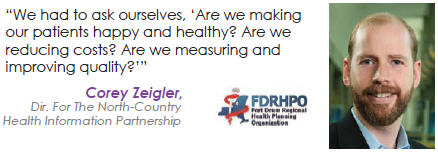Population Health Management Provides Regional View Of Care

By Katie Wike, contributing writer
The addition of population health management (PHM) technology to the Fort Drum Regional Health Planning Organization is resulting in more specific measures of processes and outcomes, as well as the ability to gather that information from EHRs in all of their PCP offices and hospitals.
Successful data management is a goal for the majority of hospitals. This was made evident in a recent article that appeared on the Health IT Outcomes website titled Population Health Management Initiatives Gaining Speed — http://bit.ly/KvcyeW. This article stated that 6 out of every 10 hospitals are currently preparing for population health management initiatives.
 The Fort Drum Regional Health Planning Organization (FDRHPO) is unique, because rather than provide services as a hospital does, the FDRHPO assists hospitals, clinics, and practices to evaluate processes and outcomes (to improve care) for the surrounding community. This includes soldiers and their families stationed at Fort Drum. The organization is a collaborative that includes seven hospitals and more than 60 practices, which are all separately owned and operated. The main office itself has fewer than 20 employees who run a myriad of projects and programs to strengthen the healthcare system, including technology to measure health outcomes and connect the network of doctors and hospitals together in order to provide coordinated access for patients in the region. While these hospitals have their own IT departments, those manage only internal data. FDRHPO collects data for the entire region and analyzes it in larger perspective. The mission of FDRHPO is to analyze the region’s health system and look for areas that need to be improved — or gaps in the system — and then gather resources so that improvements can be made. This makes their job more difficult, because unlike a single large organization, FDRHPO is a cooperative of many separately controlled entities. FDRHPO uses computer programs to assess the region’s overall health and create reports for each of the participants in the collaborative. These reports can connect patient information over different EHR platforms in separate offices. This way, primary care physicians can view data for their patients’ visits to specialists or emergency departments — no matter where they received care.
The Fort Drum Regional Health Planning Organization (FDRHPO) is unique, because rather than provide services as a hospital does, the FDRHPO assists hospitals, clinics, and practices to evaluate processes and outcomes (to improve care) for the surrounding community. This includes soldiers and their families stationed at Fort Drum. The organization is a collaborative that includes seven hospitals and more than 60 practices, which are all separately owned and operated. The main office itself has fewer than 20 employees who run a myriad of projects and programs to strengthen the healthcare system, including technology to measure health outcomes and connect the network of doctors and hospitals together in order to provide coordinated access for patients in the region. While these hospitals have their own IT departments, those manage only internal data. FDRHPO collects data for the entire region and analyzes it in larger perspective. The mission of FDRHPO is to analyze the region’s health system and look for areas that need to be improved — or gaps in the system — and then gather resources so that improvements can be made. This makes their job more difficult, because unlike a single large organization, FDRHPO is a cooperative of many separately controlled entities. FDRHPO uses computer programs to assess the region’s overall health and create reports for each of the participants in the collaborative. These reports can connect patient information over different EHR platforms in separate offices. This way, primary care physicians can view data for their patients’ visits to specialists or emergency departments — no matter where they received care.
 Disconnect In The Collaborative
Disconnect In The Collaborative
FDRHPO had no previous technology to measure regional outcomes and processes for the collaborative members. The region previously attempted to use a data warehouse application that was purchased through a grant provided through New York State’s Efficiency and Affordability Law for New Yorkers (HEAL-NY) and the Office of Health Information Technology Transformation. The problem with this application was that it used only standard interface data fields, so staff members were unable to gather the data that would provide them with the measures they needed. As a result, employees couldn’t run specific queries or produce reports and measures to meet their quality improvement initiatives. For example, when it comes to patients with COPD (chronic obstructive pulmonary disease), staff members needed to measure how many current patients were diagnosed and received certain types of treatment. With only standard interface fields, there was not enough data (or the right type of data) to answer those questions.
The problems FDRHPO encountered led to a search for a new way to collect, analyze, and share data. After a hard look at their current methods, the staff outlined their goals for installing a new PHM system. As Corey Zeigler, director for the North-Country Health Information Partnership for FDRHPO put it, “We had to ask ourselves, ‘Are we making our patients happy and healthy? Are we reducing costs? Are we measuring and improving quality? How can we best assist our region in transforming the system from a pay-per-volume system to one that is pay-for-value-based instead? What is the best way to provide better care, rather than more care?’”
PHM Solutions For A Fixed Budget
Since FDRHPO relies on government funding for the majority of its IT initiatives, the HEAL-NY grant was critical to the purchase of the new PHM solution. According to Zeigler, this made the affordability of the technology an essential factor in the decision-making process.
The chosen solution was the Wellcentive Outcome Manager disease registry coupled with their Risk Manager product for predictive analytics. Wellcentive’s PHM platform aggregates data across multiple systems, allowing individual providers who are on disparate systems to act as one large provider group — just what a collaborative such as FDRHPO needed. The Wellcentive system also allows for customizable quality measures such as care alerts that enable point-of-care decision support by the physician or staff. The platform can also access and use data from multiple EHRs and HIT systems, in addition to an individual provider’s patient population.
Running The Region Without An Army Of Analysts
The new PHM implementation began in the fall of 2012. Despite the optimism the FDRHPO staff had for their new PHM platform, integration took longer than expected. A 10-month delay was caused because a majority of their EHR vendors weren’t ready to connect, and the data required significant mapping and validation. Zeigler explains that this delay was not solely the result of the new Wellcentive technology, but rather the headache of integrating new systems with existing ones.
They are now finishing the data validation stage, so it’s too early to see the full benefits of the installation; however, the range of data that can be collected and interpreted is already much greater than before. Now, FDRHPO can measure risk utilization bands (RUBs), which use a patient’s utilization and other key data to identify patients most likely to be readmitted to the hospital or visit the ED. The region can then use that information to properly allocate resources for prevention.
Zeigler explains that the organization also measures a great deal of data related to patients with chronic diseases. With the old technology, connecting to all the region’s EHRs and pulling meaningful data from them was impossible. The new PHM system uses ICD-9 codes and lists of active patients to run queries to list how many patients in the region are diagnosed with a particular chronic condition. Staff can then refine the data to include only those who have had tests to confirm their diagnosis, then even more specifically, to those who have received appropriate treatment. This process narrows the list of patients and shows staff in the office and at the patient’s PCP what is going on in the region. Staff can also produce an actionable list of patients who have not seen their provider in the past year. Then, the patient’s PCP can call to set up an appointment and assess their condition. This prevents unnecessary (and expensive) hospitalizations, because serious illness or complications can be prevented by regular office appointments and proactive care. Reports such as these can be sent to all the physicians in the region or to specific subgroups only.
Zeigler says the biggest benefit of the new system is that it doesn’t require “an army of analysts” to organize the region’s data. FDRHPO is currently administering the regional PHM system with only 1.5 FTEs.
 He also says that with the combination of the registry and the regional HIE (HealtheConnections), physicians are happy with the new ability to look at panels, regardless of where care was provided. This is important for patients who see specialists in one office and their PCP in another. Their information is relevant no matter where they receive treatment. Physicians can look at medications prescribed and tests performed, no matter where they occurred.
He also says that with the combination of the registry and the regional HIE (HealtheConnections), physicians are happy with the new ability to look at panels, regardless of where care was provided. This is important for patients who see specialists in one office and their PCP in another. Their information is relevant no matter where they receive treatment. Physicians can look at medications prescribed and tests performed, no matter where they occurred.
While it’s still early in the process, Zeigler is happy with the new platform. “It puts a tool in the hands of decision makers at all levels. Having these kinds of analytics is decentralizing the entire process and strengthening access to process, outcome, and predictive measures.”
